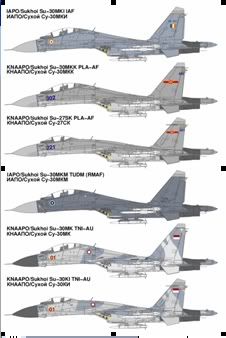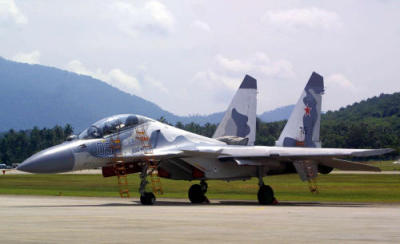Russia Postpones Delivery of Su-30MKM Jets to Malaysia
-
Russia Postpones Delivery of Su-30MKM Jets to Malaysia
Created: 14.12.2006 13:39 MSK (GMT +3), Updated: 13:39 MSK, 20 hours 35 minutes ago
MosNews
Russia will postpone delivery of Su-30MKM fighter jets to Malaysia until 2007, the management of Irkutsk aircraft manufacturing plant said on Thursday, Dec. 14. Irkutsk aircraft manufacturing plant belongs to the Irkut research and scientific association, which produces Su jets.
“The first aircraft have already been produced and tested. However, it has been decided that their delivery to the customer will be postponed,” the management told Itar-Tass agency.
The $900 million contract between the two countries for the production of 18 Su-30MKM aircraft was signed in the summer of 2003. Russian jets are set to replace seven of Malaysia’s 14 U.S.-made F-5E fighters. Back in 2005 Malaysian officials have said: “They [the U.S. fighter jets] are more than 20 years old. We had two choices — to modernize them or to replace them. We chose to make a replacement with the Russian technology.”
http://www.mosnews.com/money/2006/12/14/malaysiapostpone.shtml -
No reasons given?Originally posted by tankee1981:Russia Postpones Delivery of Su-30MKM Jets to Malaysia
Created: 14.12.2006 13:39 MSK (GMT +3), Updated: 13:39 MSK, 20 hours 35 minutes ago
http://www.mosnews.com/money/2006/12/14/malaysiapostpone.shtml -
I wonder if Malaysia will cancel this deal just like the bridge

-
Palm oil prices just dropped? Payment not enuff?Originally posted by moca:No reasons given?
-
Seeing where the article stems from, i would believe the reason has to be the money.
-
Su-30 is an incredible aircraft.
http://www.youtube.com/watch?v=eoW281mIBQU&eurl= -
no doubt about it. Russian jets are quite good.
-
when our strike eagles arriving again ? ... -
No doubt the aircraft does pose a threat to their rivals up there,Originally posted by Bhagat:Su-30 is an incredible aircraft.
http://www.youtube.com/watch?v=eoW281mIBQU&eurl=
however if we take a look at a holistic level,
the reputation of their (RUSSIA) logistic reliability,
plus RMAF's planning and logistical strategic plans,
i would wander how long the aircraft would be grounded rather than strutting it out, up there.
For those who have been following our neighbours "planning" abilities,
should know what i am driving at


-
I think Su 30 is quite a mysterious plane - i.e. it has not been used in combat and not battle proven. Yet going by most Russian weapons, they are not moulded for technical superoity but to overwhelm by numbers and ease of mass production. Like their tanks and famous AK that has became representative of terrorist (sadly).
There could be some hidden pulling and pushing behind the backs to have caused this delay, I don't think its because of payment - its not as if Malaysia cannot pay. Maybe the pilots need more training or certain systems are not ready..... -
But Su30 indeed attended a number of air exercises to vs other major fighter jets and the overall outcome is not bad
-
who will win if:
F-22 vs Su-30
or
F-35 vs Su30
-
watch 1 docu b4 in the 80s... is quality against quantity....
-

third fr bottom is RMAF version
from here
one of the founders of this site critized aussie intentiion to buy Super hornet
----Dr Carlo Kopp is a defence analyst and research fellow in regional military strategy at the Monash Asia Institute. He has flown the Super Hornet.
-
Source:
Flying into trouble - December 30, 2006
Australia is risking its credibility in the region if it pursues its plan to buy 24 Super Hornet aircraft, writes Carlo Kopp.
LAST week's disclosure of negotiations to procure 24 Boeing F/A-18F Super Hornets as interim replacements for Australia's existing F-111 fleet is the latest instalment in the sorry saga of the RAAF's decline as a credible regional air force.
Until last week, senior Defence figures repeatedly denied that Super Hornets were being sought as gap fillers to overcome continuing difficulties with the long running F/A-18A Hornet Upgrade Program, increasing delays with the Joint Strike Fighter, and Defence's campaign for premature retirement of the F-111 fleet.
The Super Hornet is the US Navy's follow-on fighter to the "Classic Hornet", currently flown by four RAAF squadrons. While slightly larger than Australia's Hornets, the Super Hornet's agility, supersonic speed and acceleration performance, critical in air combat, are no better than the earlier model, due to a Congressional mandate during development. With unique engines, radar, airframe and electronic warfare systems, the Super Hornet shares little real commonality with its predecessor, driving up support costs. All it offers is a better radar, improved avionics and 36 per cent more internal fuel, at a price tag estimated at $2.5 billion.
The bad news is that the Super Hornet is not competitive against the latest Russian Sukhoi Su-30MK fighters, operated or being acquired by China, India, Malaysia, Thailand and Indonesia, and it is also not competitive against the Boeing F-15 models being acquired by Singapore, South Korea, and flown by Japan.
The larger Sukhois are faster, much more agile, and have greater range and firepower than the Super Hornet. The Russians are now testing an advanced supersonic cruise engine in the Sukhoi fighter, which will effectively double the combat speed of the Russian fighters, putting them well out of reach of the lacklustre Super Hornet.
The Super Hornet is not a credible air combat fighter in this region, and no upgrade can ever make it so.
The stated intention to use the Super Hornet as an interim replacement for Australia's F-111s is no less incredible.
Capable of carrying about half the F-111's payload of smart bombs to about two-thirds the distance achievable by the F-111, in raw firepower terms the Super Hornet delivers around one-third the punch of the F-111.
To match the range and persistence of the F-111, the Super Hornet must be supported by aerial refuelling tanker aircraft in numbers that Defence has no intention of ever acquiring. In real terms, replacing F-111s with Super Hornets reduces strike capability three-fold.
Claims by Defence that the F-111s will become dangerous to fly after 2010 are absurd, given the advanced testing used to verify structural integrity of the fleet. Defence has repeatedly inflated the cost of operating and upgrading the F-111 in evidence to Parliament, and made factually incorrect claims on a wide range of technical issues, while publicly admitting "we don't know what we don't know". In short, the Defence leadership has no credibility whatsoever in justifying the early retirement of the F-111s. Even a fraction of the budget required to buy the Super Hornet would equip the F-111s with new engines, new wings and new avionics, allowing them to remain in use decades longer.
Compared to the mediocre Joint Strike Fighter that Defence intends as the ultimate replacement for both the F/A-18A and F-111 fleets, the Super Hornet has inferior stealth and avionics. Neither of these aircraft were designed to be credible in air combat against the latest Russian Sukhois.
Nor were they designed to defeat the advanced Russian S-300 and S-400 surface-to-air missile systems, largely superior to the US Patriot, and now appearing in this region.
In strategic terms, Defence is re-equipping the RAAF with a fleet of aircraft that will be little more than a bad joke in the region — and doing so despite better alternatives, such as the superlative F-22A, and despite repeated advice to the contrary.
Defence runs a real risk that as further difficulties emerge with the Joint Strike Fighter, and its cost continues to creep up, a future government will bale out, and with Super Hornets already in service, opt to buy more to replace the legacy Hornets. This further reduces capability against the non-credible Joint Strike Fighter plan. A far better strategy for the future of the RAAF is to scrap current planning, and start again.
The F-22A Raptor suffers none of the limitations of either the Joint Strike Fighter or Super Hornet, and is in production and operational in the US.
If Australia is to have any strategic credibility in the region, it cannot pursue the path sought by the Defence leadership.
Dr Carlo Kopp is a defence analyst and research fellow in regional military strategy at the Monash Asia Institute. He has flown the Super Hornet.
http://www.theage.com.au/news/opinion/flying-into-trouble/2006/12/29/1166895477918.html?page=fullpage#contentSwap1 -
According to Dr Carlo Kopp in the above article, both the Super Hornet and the JSF is both not good enough only the F-22 is suitable for this region. But we have plans to evetually buy the F-35. So is that a good idea?

The article also mentioned that Thailand also operate the Su-30MK. Is this true? As far as i know there is no mention of this at all before.
